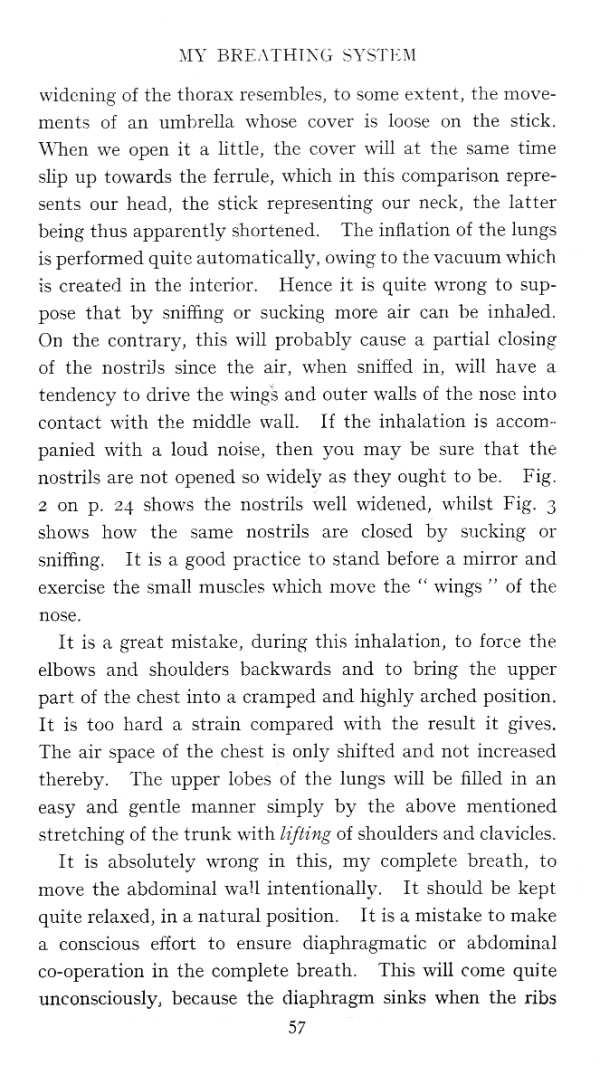88282 mbs 057

MY BRFATHING SYSTEM
widening of the thorax resembles, to some extent, the move-ments of an umbrella whose cover is loose on the stick. When we open it a little, the cover will at the same time slip up towards the ferrule, which in this comparison repre-sents our head, the stick representing our neck, the latter being tlius apparcntly shortened. The iniiation of the lungs is performed quitc automatically, owing to the vacuum which is created in the interior. Hence it is quite wrong to sup-pose that by sniffing or sucking morę air cari be inhaled. On the contrary, this will probably cause a partial closing of the nostriJs sińce the air, when sniffed in, will have a tendency to drive the wings and outer walls of the nosc into contact with the middle wali. If the inhalation is accom panied with a loud noise, then you may be surę that the nostrils are not opened so widely as they ought to be. Fig. 2 on p. 24 shows the nostrils well widened, whilst Fig. 3 shows how the same nostrils are closcd by sucking or sniffing. It is a good practice to stand before a mirror and exercise the smali muscles which move the “ wings ” of the nose.
It is a great mistake, during this inhalation, to force the elbows and shoulders baekwards and to bring the upper part of the chest into a cramped and highly arched position. It is too hard a strain compared with the result it gives. The air space of the chest is only shifted and not inereased thereby. The upper lobes of the lungs will be filled in an easy and gen tle inanner simply by the above mentioned stretching of the trunk with lifting of shoulders and claviclcs.
It is absolutely wrong in this, my complete breath, to move the abdominal wali intentionally. It should be kept quite relaxed, in a natural position. It is a mistake to make a conscious effort to ensure diaphragmatic or abdominal co-operation in the complete breath. This will come quite unconsciously, because the diapliragm sinks when the ribs
57
Wyszukiwarka
Podobne podstrony:
mbs 125 MY BRFATHING SYSTEM thus be performed vcry quickly, which is often necessaiy, but it is real
75732 mbs 060 MY BREATHING SYSTEM are widened. The completeness of inhalation is surę to be frustrat
38691 mbs 016 MY BREATHING SYSTEM One of the most comraon rcgulations for soldiers is: Chest outward
mbs 068 MY BREATHING SYSTEM I think I was the first author who prescribed exactly, in each single cx
mbs 073 MY BREATHING SYSTEM Even if the heart has been weakened by athletics badly per-formed, it is
mbs 045 MY BRKATHINTt SYSTEM our breathing ? ” The author (Dr. Hulbert) submits that this is accompl
mbs 029 MY BREATIIING SYSTEM exhale tlirough the nose, we are bound to do it slowly. But if exhalati
więcej podobnych podstron